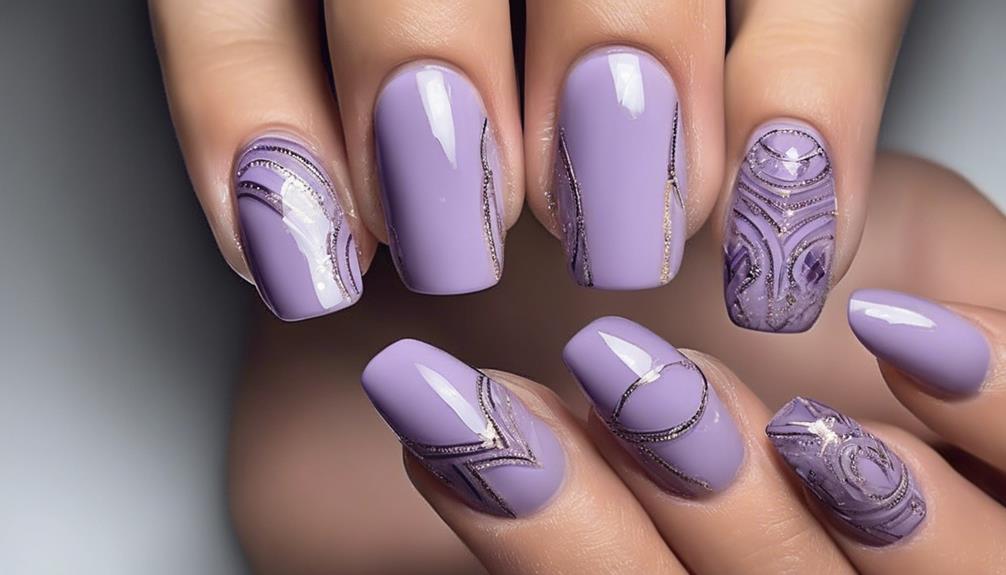Glycolic acid peels can transform your skincare routine by providing deep exfoliation, which promotes cell turnover and reveals healthier skin. This powerful alpha hydroxy acid helps reduce fine lines, improve uneven skin tone, and combat acne scars. With its small molecular size, it penetrates deeply, enhancing its effects. You'll want to start slow if you're new to peels—apply once a week and gradually increase as your skin adjusts. Post-peel care is essential to maintain hydration and protect your skin. There's much more to explore about how to maximize your results and guarantee a successful experience.
Key Takeaways
- Glycolic acid peels enhance skin cell renewal, improving texture and reducing signs of aging like fine lines and wrinkles.
- Regular use can help address skin concerns such as acne scars, hyperpigmentation, and uneven skin tone for a more radiant complexion.
- Start with lower concentrations and fewer applications to gauge skin tolerance before gradually increasing frequency.
- Always follow up with a hydrating moisturizer and broad-spectrum SPF 30 or higher to protect the skin post-peel.
What Is Glycolic Acid?
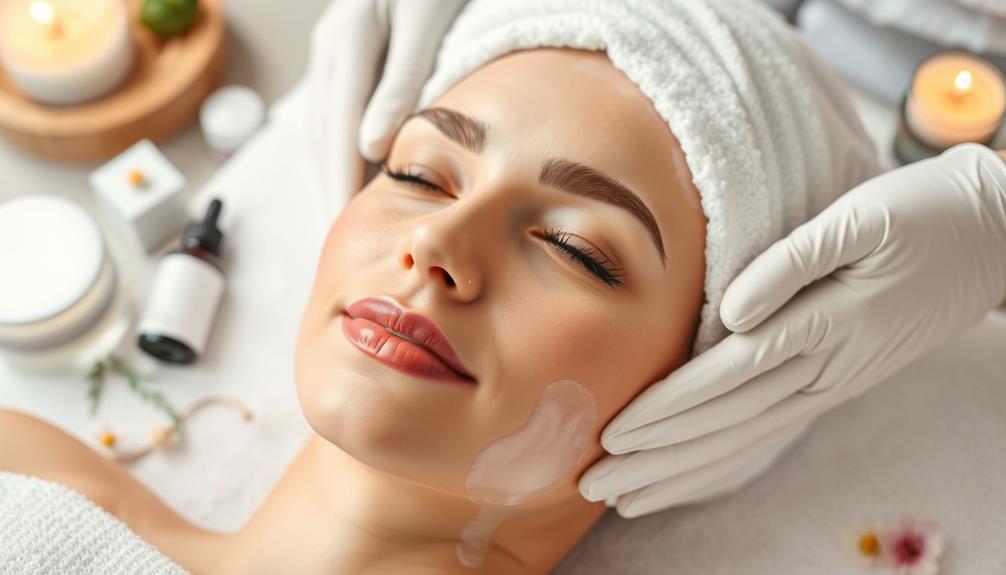
Glycolic acid is a potent alpha hydroxy acid derived from sugarcane that's known for its ability to deeply penetrate the skin and promote a smoother complexion. As one of the most effective chemical exfoliants, it works by breaking down the bonds between dead skin cells. This action not only reveals fresher skin beneath but also helps address various skin concerns, like fine lines, wrinkles, acne, dark spots, and uneven skin tone.
Additionally, incorporating ingredients that promote relaxation, such as rooibos tea's calming effects, can further enhance your skincare routine by reducing stress-related skin issues.
Incorporating glycolic acid into your skincare routine can greatly enhance your skin's overall appearance. Its small molecular size allows it to reach deeper layers, making it more effective than other alpha-hydroxy acids. Regular use can also stimulate collagen production, improving your skin's elasticity and texture over time.
While glycolic acid is suitable for most skin types, it's important to start gradually and perform patch tests if you have sensitive skin. This way, you can enjoy the benefits of this powerful ingredient without unwanted irritation.
Benefits of Glycolic Acid Peels

Revealing smoother, brighter skin is one of the many benefits you can enjoy from regular glycolic acid peels. This powerful ingredient goes beyond just surface results, offering a variety of advantages for your skin.
For instance, you can complement your skincare routine with natural alternatives like essential oils to enhance overall well-being and promote relaxation through aromatherapy practices, such as essential oil blends for relaxation.
Here's what you can expect:
- Reduces the Appearance of Fine Lines: Glycolic acid promotes collagen production, helping to diminish fine lines and enhance elasticity.
- Improves Skin Tone and Texture: By accelerating cell turnover, these peels refine your skin's texture, leaving it looking fresh and vibrant.
- Targets Acne Scars and Hyperpigmentation: Glycolic acid effectively reduces the appearance of acne scars, melasma, and uneven skin tone, making it a great option for various skin concerns.
- Enhances Overall Skin Health: Regular use helps combat dull complexions and large pores, boosting your skin's overall appearance.
Incorporating glycolic acid peels into your skincare routine can truly transform your skin. You'll not only notice immediate improvements but also long-term benefits as your skin becomes healthier and more radiant.
How Glycolic Acid Works
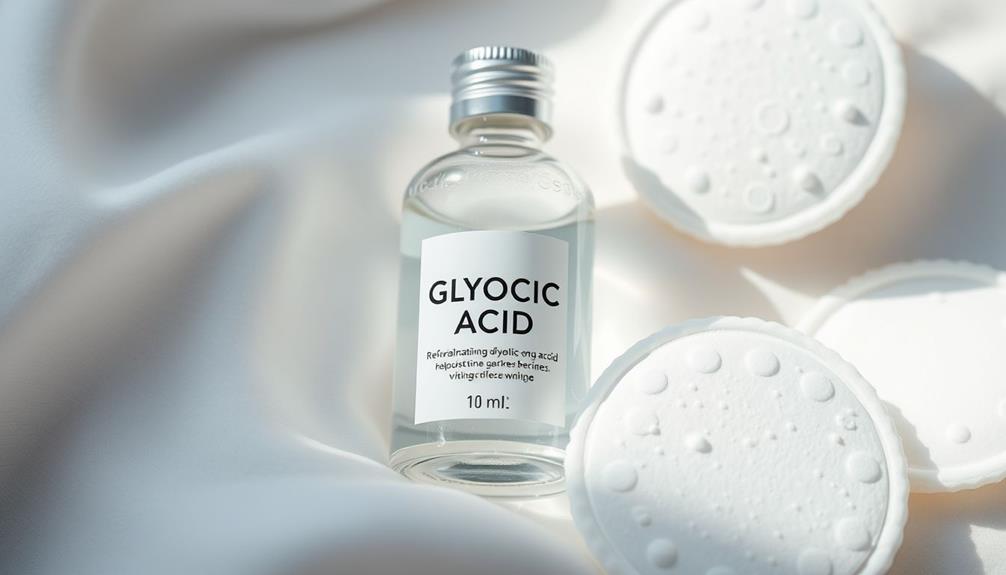
Glycolic acid works through a chemical exfoliation process that breaks down the bonds between dead skin cells, making it easier for your skin to shed them.
This process not only enhances skin cell renewal but can also be complemented by other holistic methods, such as essential oils for skin treatment.
With regular use, you'll notice improvements in texture, tone, and overall skin health.
Chemical Exfoliation Process
Chemical exfoliation with glycolic acid effectively loosens the bonds between dead skin cells, making it easier for them to be sloughed off. This process not only reveals fresher skin but also contributes to a smoother skin texture.
When you incorporate regular use of glycolic acid into your routine, you can expect several benefits:
- Deeper Penetration: Due to its small molecular size, glycolic acid penetrates deeper into the skin, enhancing cellular turnover.
- Improved Elasticity: Glycolic acid stimulates collagen production, which helps improve skin elasticity and reduces fine lines.
- Optimal pH Environment: When applied, glycolic acid lowers your skin's pH, creating the perfect environment for effective chemical exfoliation.
- Targeted Treatment: Regular use of glycolic acid can address issues like hyperpigmentation, acne, and photoaging, leading to a more even skin tone.
Skin Cell Renewal
By loosening the bonds between dead skin cells, glycolic acid promotes quicker skin cell renewal, leading to a brighter and more youthful complexion.
As an alpha hydroxy acid (AHA), glycolic acid's small molecular size allows it to penetrate deeply into the skin, effectively stimulating cellular regeneration. This process accelerates your skin's natural turnover cycle, which typically lasts about 28 days.
With regular use of glycolic acid, you can experience enhanced exfoliation, helping to shed those dull, dead skin cells. This not only reveals fresher skin but also reduces the appearance of fine lines and wrinkles.
Additionally, glycolic acid is effective in tackling hyperpigmentation, as it encourages even skin tone and texture.
To maximize the benefits, it's important to use glycolic acid at a prime pH of around 3.5. This guarantees effective skin cell renewal without causing excessive irritation.
As you incorporate glycolic acid peels into your skincare routine, you'll notice a significant improvement in your skin's overall appearance, making it a powerful ally in your quest for healthier, more radiant skin.
Safe Application Procedures
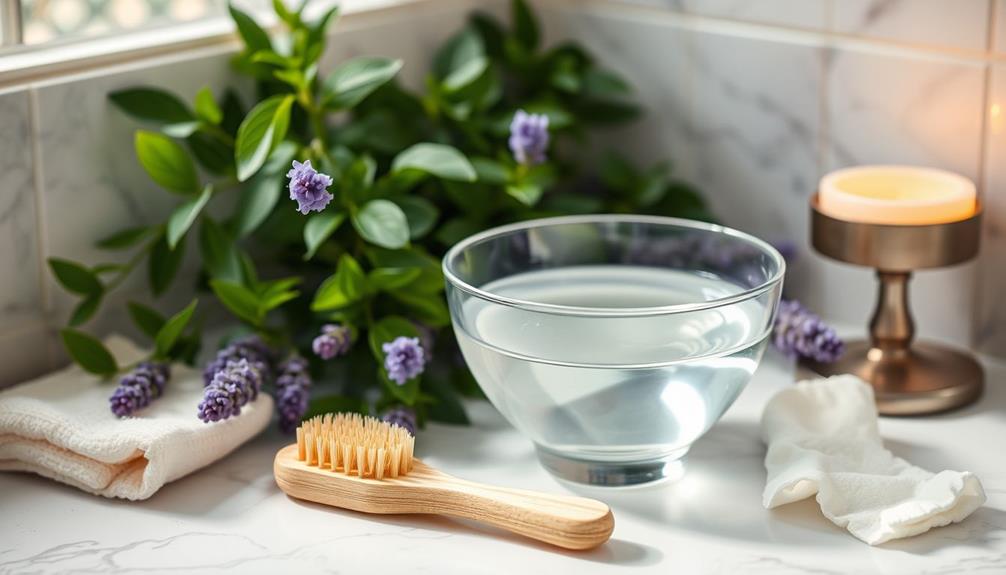
Before you apply a glycolic acid peel, make certain your skin is clean and free of impurities.
After the peel, it's essential to follow proper post-peel care to soothe and protect your skin.
Let's explore the steps for both preparation and aftercare to guarantee a safe and effective experience.
Preparation Before Application
To guarantee the glycolic acid peel works effectively, start by thoroughly cleansing your skin with a gentle cleanser to remove any makeup, dirt, or oils. This step is essential for ensuring the peel can penetrate your skin properly.
Before diving in, follow these preparation tips:
- Patch Test: Always perform a patch test on a small area to see how your skin tolerates the glycolic acid before applying it more broadly.
- Avoid Other Actives: On the night of the peel, refrain from using other exfoliating products or active ingredients to prevent excessive irritation.
- Application Method: Use a cotton pad or your fingertips to apply glycolic acid evenly, steering clear of sensitive areas like your lips and eyes.
- Timing: Start with an initial application time of 1 minute. Gradually increase to a maximum of 2 minutes as your skin tolerates the treatment.
Post-Peel Care Tips
What should you do immediately after a glycolic acid peel to make certain your skin recovers effectively? First, rinse off the peel and any neutralizing mask thoroughly to prevent prolonged irritation. Next, pay close attention to your skin's needs during the post-peel care phase.
Here's a quick guide to help you:
| Post-Peel Care Tips | Action |
|---|---|
| 1. Rinse Thoroughly | Remove peel and masks completely. |
| 2. Apply Hydration | Use a Hydration Peptide Cream. |
| 3. Monitor Skin | Check for redness or irritation. |
| 4. Apply Sunscreen | Use SPF 30 or higher during the day. |
| 5. Use Gentle Moisturizers | Choose non-exfoliating options. |
Hydration is key after a peel, so make certain you're using moisturizers that support skin recovery. If you notice any redness or irritation, allow your skin time to heal and consider reducing the frequency of future peels. By following these tips, you'll enhance your skin's recovery and maintain its health post-peel.
Post-Peel Skin Care

After a glycolic acid peel, taking proper care of your skin is crucial to promote healing and enhance results. Your skin may feel red and sensitive, so focus on a post-peel care routine that prioritizes hydration and protection.
Here are four key steps to follow:
- Rinse Thoroughly: Make sure to rinse off any remaining peel or neutralizing mask to remove potential irritants.
- Hydration: Apply a Hydration Peptide Cream, which contains soothing ingredients like peptides and ceramides to deeply hydrate your skin.
- Moisturization: Consistent moisturization is essential. Use a gentle moisturizer to lock in hydration and minimize dryness and irritation.
- SPF Protection: Since your skin will be more sensitive to the sun, never skip a broad-spectrum SPF moisturizer. Apply it daily to shield your skin from UV damage.
Frequency of Use
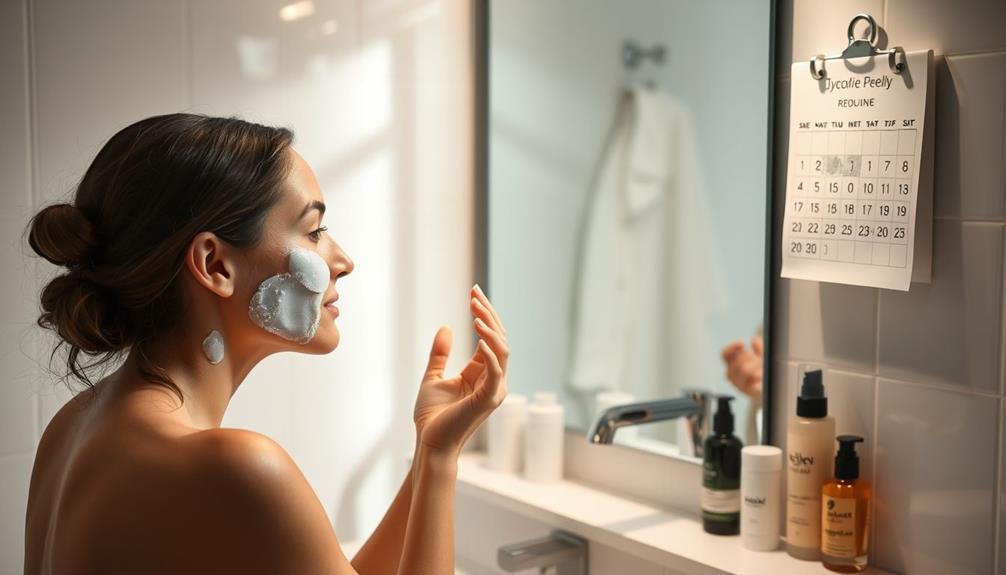
Finding the right frequency for glycolic acid peels depends on your skin type and tolerance levels.
If you have sensitive skin, it's best to start with a peel once a week and gradually increase the frequency as your skin adapts.
For those with oily or acne-prone skin, you might find that you can handle glycolic acid peels more frequently, allowing for better management of breakouts.
Begin with a low concentration peel to minimize the risk of irritation.
As your skin builds tolerance, you can increase the strength of the peels.
A good starting point for most skin types is to use glycolic acid peels 2-3 times a week for ideal benefits.
However, pay attention to your skin's response.
Signs of irritation, such as redness or stinging, should prompt you to reduce the frequency of use.
Potential Side Effects
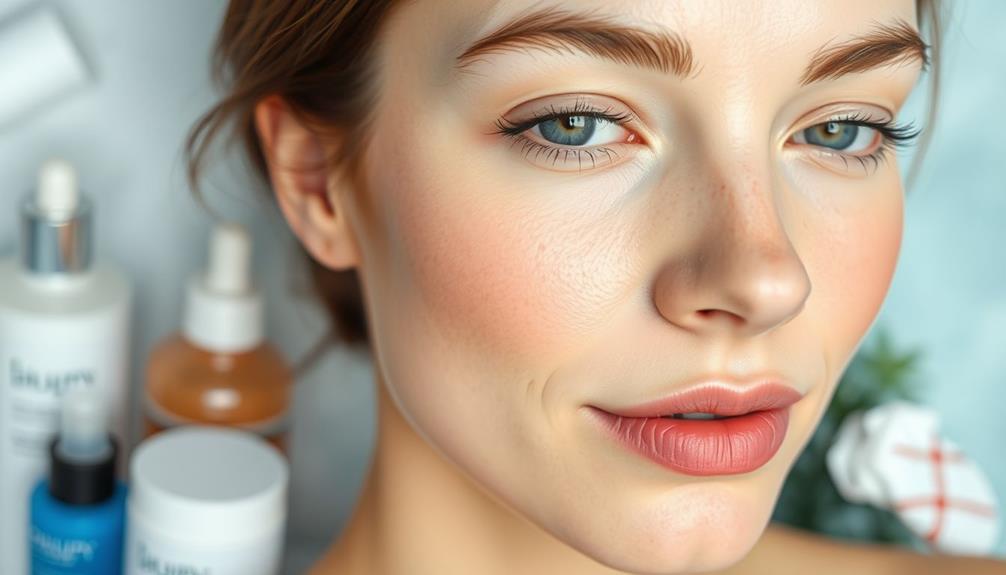
When using glycolic acid peels, you might notice some common irritation symptoms like redness or stinging, especially if you have sensitive skin.
To minimize these side effects, it's essential to start with lower concentrations and gradually adjust your routine.
Always pay attention to how your skin reacts, and don't hesitate to consult a dermatologist if needed.
Common Irritation Symptoms
Many users experience irritation symptoms like redness, stinging, and a burning sensation, especially if they've sensitive skin. These common irritation symptoms can be concerning, but they often indicate your skin is responding to glycolic acid products.
Here are some key effects you might notice:
- Redness and Stinging: This is particularly prevalent in sensitive skin, as the glycolic acid penetrates and exfoliates.
- Dryness or Peeling: As your skin barrier regenerates, you may experience some dryness or flakiness as dead skin cells are removed.
- Sun Sensitivity: After a glycolic acid peel, your skin can become more sensitive to the sun, making sunscreen application essential.
- Temporary Discoloration: Some individuals, especially those with darker skin tones, might notice temporary changes in pigmentation.
It's important to listen to your skin. If you find these irritation symptoms persist or worsen, consider adjusting the frequency of application or looking for lower concentration glycolic acid products.
Always prioritize the health of your skin barrier and protect it diligently.
Minimizing Side Effects
How can you effectively minimize the side effects of glycolic acid peels while still enjoying their benefits?
Start by choosing a lower concentration of glycolic acid, especially if you have sensitive skin. Gradually increase the frequency of use as your skin builds tolerance. This slow approach helps reduce potential redness and irritation.
Before diving into a full application, make sure to conduct patch testing on a small area of your skin. This step allows you to gauge how your skin reacts and helps you avoid widespread irritation.
After each glycolic acid peel, always apply a hydrating moisturizer to soothe and combat excessive dryness.
Combining With Other Ingredients
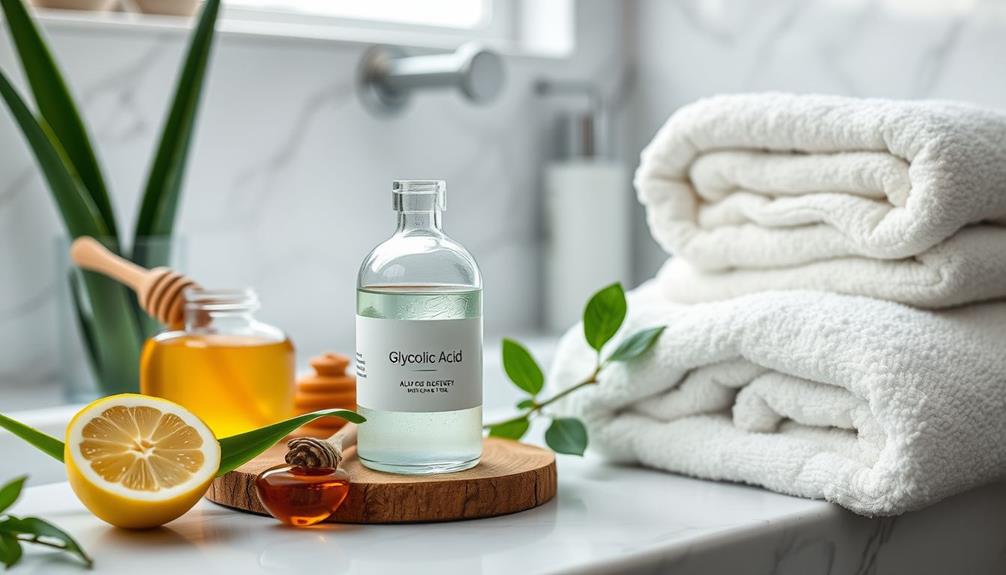
Combining glycolic acid with other skincare ingredients can enhance its benefits while addressing various skin concerns. By strategically layering ingredients, you can optimize your routine while being mindful of skin sensitivity.
Here are some effective combinations to take into account:
- Glycolic Acid and Vitamin C: Use vitamin C in the morning for a brightening effect and glycolic acid at night to promote cell turnover. This pairing helps achieve a radiant complexion.
- Glycolic Acid and Niacinamide: Niacinamide soothes irritation and reduces redness, making it a great companion for glycolic acid. Together, they can enhance skin texture without compromising comfort.
- Glycolic Acid and Hyaluronic Acid: To boost hydration, layer hyaluronic acid after glycolic acid. While glycolic acid exfoliates, hyaluronic acid locks in moisture, preventing dryness.
- Glycolic Acid and Retinol: If you want to use retinol, alternate nights with glycolic acid. Both can be potent, so this method minimizes the risk of irritation.
Remember to introduce these combinations gradually, observing how your skin reacts to guarantee a balanced routine.
Recommended Products
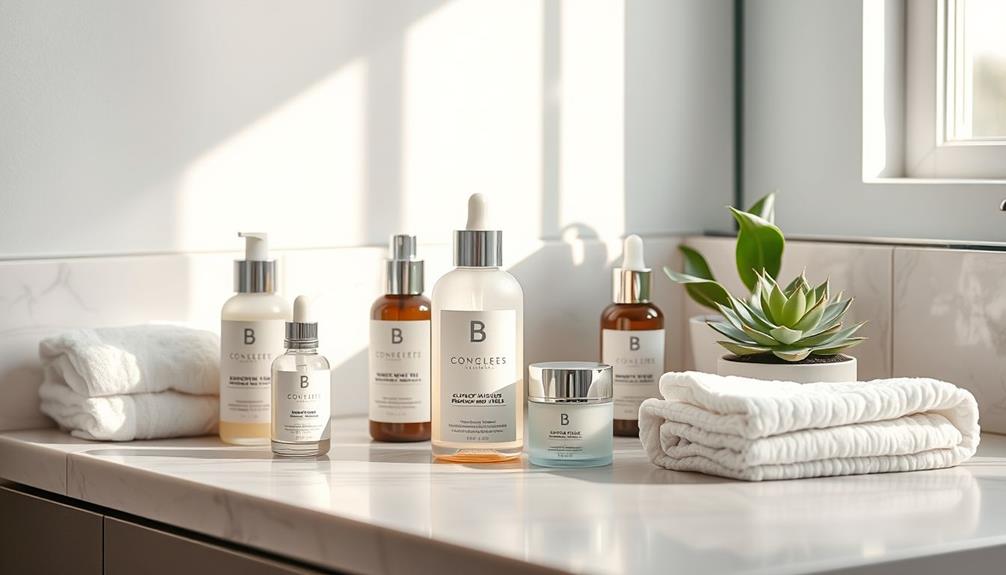
To enhance your glycolic acid skincare routine, consider incorporating these recommended products that cater to various needs and preferences.
Start with the Exfoliating Toner, which contains 8% Glycolic Acid for just $31.90. It's great for improving skin texture and promoting brighter skin.
If you're looking for something more concentrated, try the Exfoliating Serum with 10% Glycolic Acid, starting at $25.60. This product effectively targets uneven skin tone and fine lines, providing noticeable anti-aging effects.
For body care, the Anti-Blemish Body Wash includes 6% Glycolic Acid at $20.90, specifically designed to combat body acne and unclog pores.
If you're after a powerful treatment, the Resurfacing Mask combines 10% AHA and 10% PHA for a thorough exfoliation experience at $45.90, enhancing both clarity and texture.
Finally, the Exfoliating Night Cream features 6% AHA and soothing lavender extract, priced at $42.90. This cream hydrates overnight while supporting gentle exfoliation for smoother skin.
With these products, you can effectively address your skincare concerns while enjoying the benefits of glycolic acid.
Tips for Optimal Results
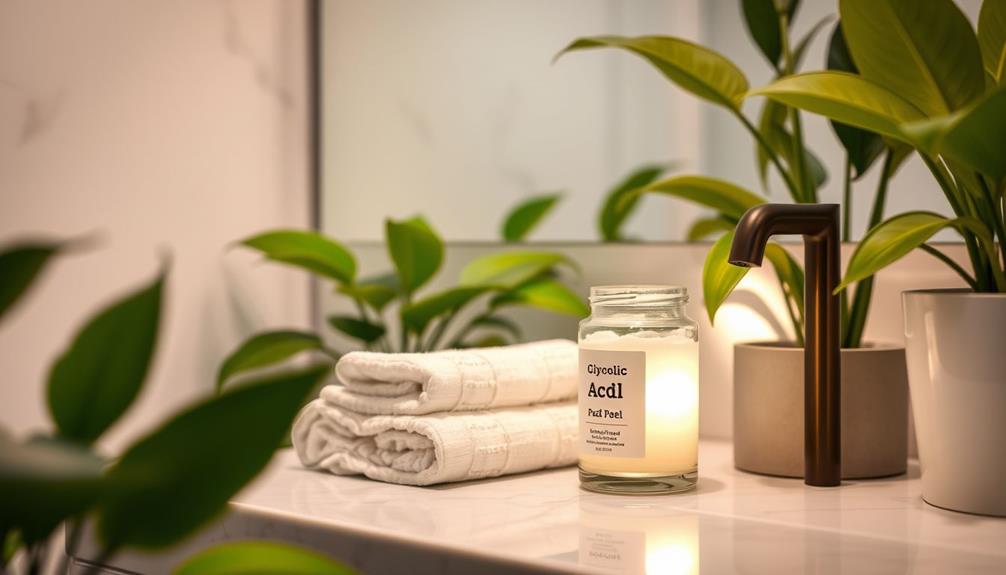
Achieving ideal results from your glycolic acid peel involves starting with lower concentrations and gradually increasing strength as your skin adapts. This approach helps you manage sensitivity and irritation while effectively targeting uneven skin. Glycolic acid peel benefits include reducing the appearance of fine lines and wrinkles, increasing collagen production, and improving overall skin texture and tone. By gradually increasing the strength of your peel, you can maximize these benefits and minimize any potential negative effects. It’s also important to follow up with a good skincare routine that includes moisturizing and applying sunscreen, as your skin will be more sensitive to the sun after a glycolic acid peel.
Here are four tips to guarantee you get the most out of your glycolic acid peel:
- Start Slow: Begin with 1-2 applications per week using lower concentrations of glycolic acid. Gradually increase frequency as your skin builds tolerance.
- Patch Test: Always perform a patch test before full application. This helps identify any potential allergic reactions or sensitivities to the skincare products you're using.
- Nighttime Application: Apply the peel in the evening to minimize sun exposure. During the day, use a broad-spectrum SPF of at least 30 to protect your skin from increased sensitivity.
- Hydration is Key: After the peel, follow up with a hydrating moisturizer containing ingredients like squalane or hyaluronic acid. This will help soothe and hydrate your skin, keeping it healthy and balanced.
Frequently Asked Questions
When to Use Glycolic Acid in Skincare Routine?
You should use glycolic acid at night to minimize sun sensitivity. Start with short applications, gradually increasing time as your skin adjusts. Cleanse beforehand, and always follow up with sunscreen during the day for protection.
How Do You Fit Glycolic Acid Into Skincare Routine?
To fit glycolic acid into your skincare routine, start with a mild cleanser or toner. Apply it a few times weekly, gradually increasing frequency, and always follow with a moisturizer and daily SPF for protection.
What Does Glycolic Peel Do to Your Skin?
You might think your skin's fine as is, but a glycolic peel reveals the truth. It exfoliates, reduces signs of aging, clears pores, and enhances texture, giving you that radiant glow you didn't know you needed.
How Often Should You Use Glycolic Acid Peel?
You should start with a low concentration glycolic acid peel once a week. If your skin tolerates it well, gradually increase to 2-3 times weekly, adjusting based on any signs of irritation you notice.
Conclusion
Incorporating glycolic acid peels into your skincare routine can transform your complexion, revealing brighter, smoother skin.
You'll love how this powerhouse ingredient helps reduce signs of aging and enhances your overall glow.
But are you ready to access the full potential of your skin?
By following safe application procedures and post-peel care, you can maximize your results.
Embrace the journey to radiant skin and see the difference glycolic acid can make in your daily regimen!



